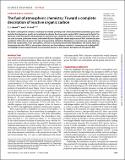| dc.contributor.author | Heald, Colette L. | |
| dc.contributor.author | Kroll, Jesse | |
| dc.date.accessioned | 2020-06-12T22:22:40Z | |
| dc.date.available | 2020-06-12T22:22:40Z | |
| dc.date.issued | 2020-02 | |
| dc.date.submitted | 2019-07 | |
| dc.identifier.issn | 2375-2548 | |
| dc.identifier.uri | https://hdl.handle.net/1721.1/125791 | |
| dc.description.abstract | The Earth’s atmosphere contains a multitude of emitted (primary) and chemically formed (secondary) gases and particles that degrade air quality and modulate the climate. Reactive organic carbon (ROC) species are the fuel of the chemistry of the atmosphere, dominating short-lived emissions, reactivity, and the secondary production of key species such as ozone, particulate matter, and carbon dioxide. Despite the central importance of ROC, the diversity and complexity of this class of species has been a longstanding obstacle to developing a comprehensive understanding of how the composition of our atmosphere, and the associated environmental implications, will evolve. Here, we characterize the role of ROC in atmospheric chemistry and the challenges inherent in measuring and modeling ROC, and highlight recent progress toward achieving mass closure for the complete description of atmospheric ROC. Copyright ©2020 The Authors, some rights reserved; | en_US |
| dc.description.sponsorship | U.S. NSF (grant no. AGS-1564495) | en_US |
| dc.description.sponsorship | U.S. NSF (grant no. AGS-1638672) | en_US |
| dc.language.iso | en | |
| dc.publisher | American Association for the Advancement of Science (AAAS) | en_US |
| dc.relation.isversionof | https://dx.doi.org/10.1126/sciadv.aay8967 | en_US |
| dc.rights | Creative Commons Attribution NonCommercial License 4.0 | en_US |
| dc.rights.uri | https://creativecommons.org/licenses/by-nc/4.0/ | en_US |
| dc.source | Science Advances | en_US |
| dc.title | The fuel of atmospheric chemistry: Toward a complete description of reactive organic carbon | en_US |
| dc.type | Article | en_US |
| dc.identifier.citation | Heald, C. L. and J. H. Kroll, "The fuel of atmospheric chemistry: Toward a complete description of reactive organic carbon." Science Advances 6, 6 (February 2020): no. eaay8967 doi. 10.1126/sciadv.aay8967 ©2020 Authors | en_US |
| dc.contributor.department | Massachusetts Institute of Technology. Department of Civil and Environmental Engineering | en_US |
| dc.contributor.department | Massachusetts Institute of Technology. Department of Earth, Atmospheric, and Planetary Sciences | en_US |
| dc.contributor.department | Massachusetts Institute of Technology. Department of Chemical Engineering | en_US |
| dc.relation.journal | Science Advances | en_US |
| dc.eprint.version | Final published version | en_US |
| dc.type.uri | http://purl.org/eprint/type/JournalArticle | en_US |
| eprint.status | http://purl.org/eprint/status/PeerReviewed | en_US |
| dc.date.updated | 2020-05-27T17:43:34Z | |
| dspace.date.submission | 2020-05-27T17:43:36Z | |
| mit.journal.volume | 6 | en_US |
| mit.journal.issue | 6 | en_US |
| mit.license | PUBLISHER_CC | |
| mit.metadata.status | Complete | |
